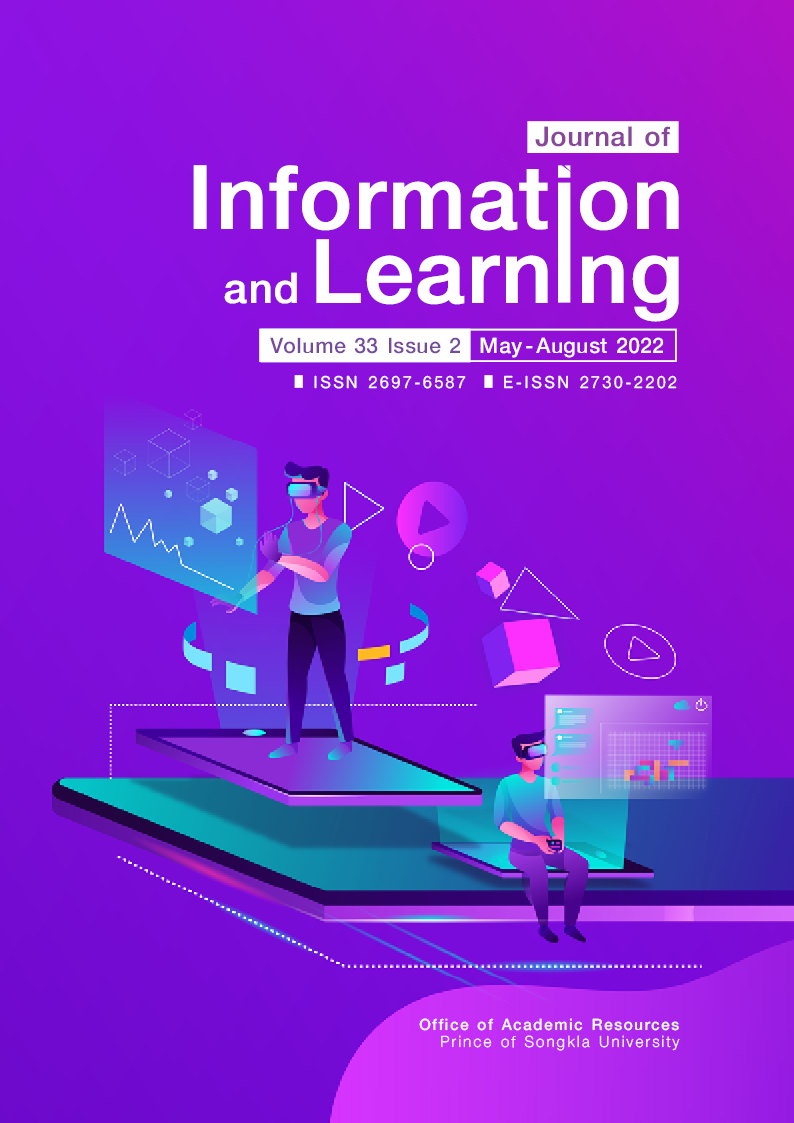ระบบการจัดการเรียนรู้ร่วมกันด้วยทีมเสมือนจริงบนเทคโนโลยีคลาวด์เพื่อส่งเสริมทักษะการทำงานร่วมกันสำหรับนักศึกษาระดับปริญญาตรี
Main Article Content
บทคัดย่อ
การวิจัยครั้งนี้มีวัตถุประสงค์เพื่อ 1) สังเคราะห์และประเมินรูปแบบการเรียนรู้ร่วมกันด้วยทีมเสมือนจริงบนเทคโนโลยีคลาวด์เพื่อส่งเสริมทักษะการทำงานร่วมกันสำหรับนักศึกษาปริญญาตรี 2) พัฒนาระบบการจัดการเรียนรู้ร่วมกันด้วยทีมเสมือนจริงบนเทคโนโลยีคลาวด์ 3) ศึกษาผลการใช้ระบบการจัดการเรียนรู้ที่พัฒนาขึ้น วิธีดำเนินการวิจัยแบ่งออกเป็น 3 ระยะ ได้แก่ สังเคราะห์และประเมินรูปแบบการเรียนรู้ พัฒนาระบบการจัดการเรียนรู้ ศึกษาผลการใช้ระบบการจัดการเรียนรู้ เครื่องมือที่ใช้ในการวิจัย ได้แก่ รูปแบบการเรียนรู้ ระบบการจัดการเรียนรู้ที่พัฒนาขึ้น แบบทดสอบวัดผลสัมฤทธิ์ทางการเรียน แบบประเมินทักษะการทำงานร่วมกัน และแบบประเมินความพึงพอใจ สถิติที่ใช้ในการวิจัย ได้แก่ ค่าเฉลี่ย ส่วนเบี่ยงเบนมาตรฐาน และการทดสอบค่าที (t-test)
ผลการวิจัยพบว่า 1) ผลการประเมินความเหมาะสมของรูปแบบการเรียนรู้อยู่ในระดับมากที่สุด (=4.64, S.D.=0.53) 2) ผลการประเมินคุณภาพของระบบการจัดการเรียนรู้ที่พัฒนาขึ้น ด้านเนื้อหาอยู่ในระดับมากที่สุด (
=4.51, S.D.=0.56) ด้านเทคนิควิธีการอยู่ในระดับมากที่สุด (
=4.59, S.D.=0.52) 3) ผลสัมฤทธิ์ทางการเรียนของผู้เรียนหลังเรียนด้วยระบบการจัดการเรียนรู้ที่พัฒนาขึ้นสูงกว่าก่อนเรียนอย่างมีนัยสำคัญทางสถิติที่ระดับ .05 ทักษะการเรียนรู้ร่วมกันของผู้เรียนที่เรียนด้วยระบบการจัดการเรียนรู้ที่พัฒนาขึ้นในภาพรวมอยู่ในระดับมากที่สุด (
=4.52, S.D.=0.51) และผู้เรียนมีความพึงพอใจต่อระบบการจัดการเรียนรู้ที่พัฒนาขึ้นโดยรวมอยู่ในระดับมากที่สุด (
=4.57, S.D.=0.61)
Article Details

อนุญาตภายใต้เงื่อนไข Creative Commons Attribution-NonCommercial-NoDerivatives 4.0 International License.
Journal of Information and Learning ดำเนินการโดยสำนักวิทยบริการ มหาวิทยาลัยสงขลานครินทร์ วิทยาเขตปัตตานี บทความที่ได้รับการตีพิมพ์ในวารสารได้รับความคุ้มครองตามกฎหมายลิขสิทธิ์ โดยเจ้าของลิขสิทธิ์จะมีสิทธิในการทำซ้ำ ดัดแปลง และเผยแพร่งานบทความ ทั้งรูปแบบอิเล็กทรอนิกส์ การทำฉบับสำเนา การแปล และการผลิตซ้ำในรูปแบบต่างๆ ลิขสิทธิ์บทความเป็นของผู้เขียนและสำนักวิทยบริการ มหาวิทยาลัยสงขลานครินทร์ วิทยาเขตปัตตานี วารสารฯ ขอสงวนสิทธิ์ในการพิจารณาตีพิมพ์ตามความเหมาะสม รวมทั้งการตรวจทานแก้ไข การปรับข้อความ หรือขัดเกลาภาษาให้ถูกต้องตามเกณฑ์ที่กำหนด สำหรับผลการวิจัยและความคิดเห็นที่ปรากฏในบทความถือเป็นความคิดเห็นและอยู่ในความรับผิดชอบของผู้เขียน
เอกสารอ้างอิง
Alshuwaier, F. A., Alshuwaier, A. A., & Areshey, A. M. (2012). Applications of cloud computing in education [Paper presentation]. The 8th International Conference on Computing and Networking Technology (ICCNT), Gueongju, Korea.
Ashtari, S., & Eydgahi, A. (2017). Student perceptions of cloud applications effectiveness in higher education. Journal of computational science, 23(1), 173-180.
Boonprasom, C., & Sintanakul, K. (2019). The synthesis of model of collaborative learning using problem-based learning on cloud to enhance critical thinking of undergraduate students. Journal of Industrial Education, 18(3), 165-173
Duangnim, A., Napapongs, W., Kaosaiyaporn, O., Tansakul, J., & Inkaew, C. (2021). Development of massive open online learning environments to promote self-directed learning based on constructivist approach. Journal of Information and Learning, 32(3), 1-13.
Eteokleous, N., & Ktoridou, D. (2012). Community of inquiry developed through cloud computing for MIS courses [Paper presentation]. IEEE Global Engineering Education Conference (EDUCON), Marrakech, Morocco.
Friend, M., & Cook, L. (2007). Interactions: Collaboration skills for school professionals (5th ed.). Pearson Education.
Jaidee, M. (2015). The development of a model for problem-based learning cooperates with KWL plus technique using scaffoldings system to develop critical thinking [Unpublished doctoral dissertation]. King Mongkut's University of Technology North Bangkok.
Kankaew, V., & Jeerungsuwan, N. (2015). The design of collaborative learning pattern through the use of cloud technology for supporting the college students’ creative thinking. Technical Education Journal King Mongkut’s University of Technology North Bangkok, 6(1), 197-204.
Laisema, S. (2015). Ubiquitous learning environment-based virtual collaborative learning system for creative problem solving to enhance creative thinking and collaboration skills [Unpublished doctoral dissertation]. King Mongkut's University of Technology North Bangkok.
Laisema, S., Wanpiroon, P., & Nilsook, P. (2015). Ubiquitous collaborative virtual teams learning management system [Paper presentation]. The 29th National Conference on Educational Technology (NCET2015), Bangkok, Thailand.
Lin, Y. T., Wen, M. L., Jou, M., & Wu, D. W. (2014). A cloud-based learning environment for developing student reflection abilities. Computers in Human Behavior, 32, 244-252.
Moungsawad, A., Sirisombat, D., Mekintharanggur, K., & Hongsakul, B. (2021). Online education administration guidelines for aviation management undergraduates. Journal of Information and Learning, 32(1), 51-61.
Office of the Education Council. (2017, February 5). Phǣnkān sưksā hǣng chāt Phō̜.Sō̜. 2560-2579 [National Education Plan 2017-2036]. Lampang Province. http://www.lampang.go.th/public60/EducationPlan2.pdf
Partnership for 21st Century Learning. (2015, February 5). P21 Framework Definition. Battelleforkids. http://www.p21.org/storage/documents/P21_Framework_Definitions.pdf
Preechanonth, S. (2021). The development of a cloud-based blended learning model using Synectic’s approach and lateral thinking technique to enhance photography creative problem-solving ability for Rajabhat university students [Unpublished doctoral dissertation]. Silpakorn University.
Rattanathirakul, A. (2018). Education as a Service for Instructional in the Digital Age. Journal of Pacific Institute of Management Science, 4(1), 308-320.
Saenboonsong, S. (2017). The develop of flipped classroom using cloud technology approach on academic achievement in computer science for teacher course for undergraduate students. Journal of Graduate Studies Valaya Alongkorn Rajabhat University, 11, 133-146.
Siharak, S. (2008). Develop the instructional model based on team learning principles and to verify its effectiveness to enhance team learning skills and learning achievement of Mathayomsuksa four students [Unpublished doctoral dissertation]. Chulalongkorn University.
Srisa-ard, B. (2002). Kānwičhai bư̄angton [Basic research] (7th ed.). Suweeriyasan.
Srisakonsub, P., & Jeerungsuwan, N. (2015). The design of collaborative learning using cloud computing technology in order to improve the 21st century learning skills for college students. Technical Education Journal King Mongkut’s University of Technology North Bangkok, 6(2), 12-18.
Stanley, D., & Zhang, Y. J. (2020). Collaborative learning in online business education: Evidence from a field experiment. Journal of Education for Business, 95(8), 506–512.
Stauffer, B. (2021, July 25). What’s the difference between online learning and distance Learning? AES Education. https://www.aeseducation.com/blog/online-learning-vs-distance-learning
UNESCO. (2021, October 17). COVID-19 educational disruption and response. UNESCO. https://en.unesco.org/news/covid-19-educational-disruption-and-response


